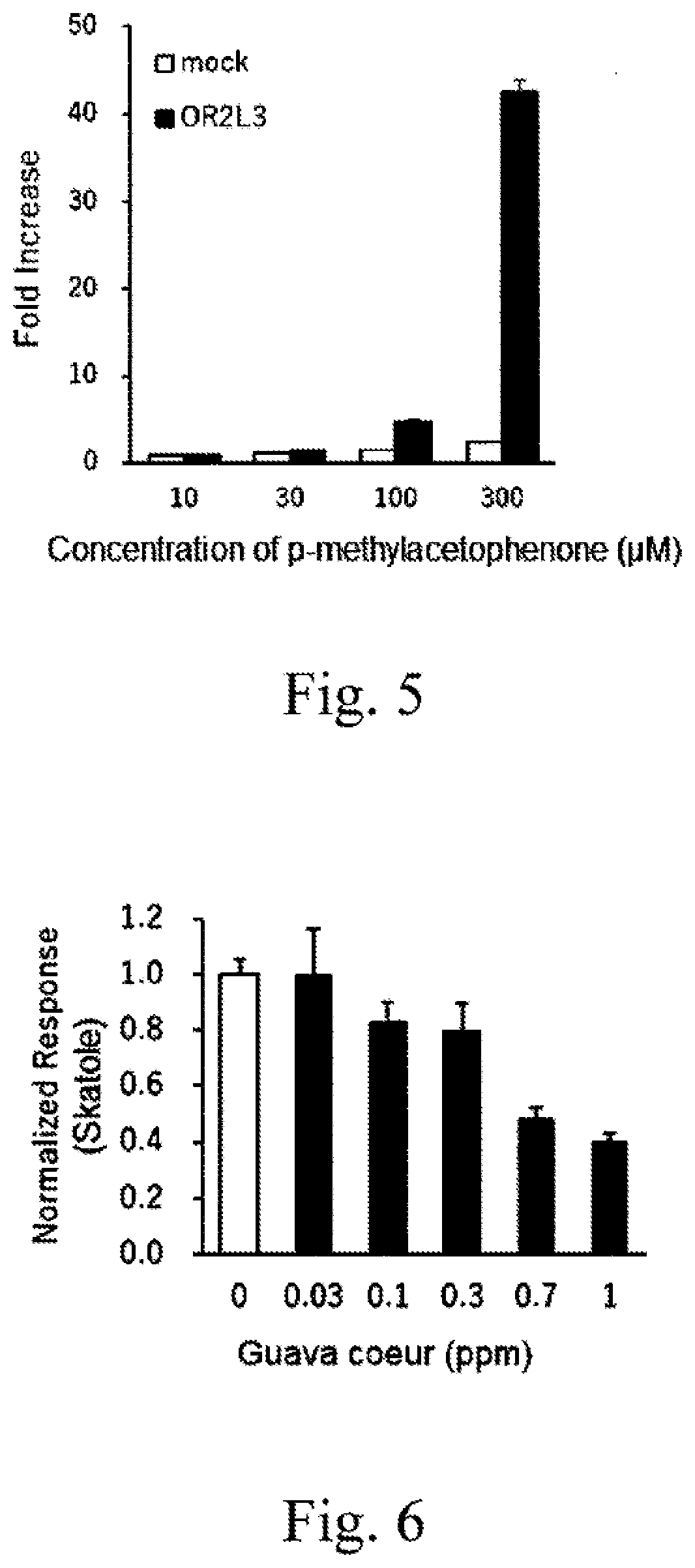Fragrance composition
- Summary
- Abstract
- Description
- Claims
- Application Information
AI Technical Summary
Benefits of technology
Problems solved by technology
Method used
Image
Examples
example 1
Confirmation of Response of Olfactory Receptor OR2L3 to Unpleasant Odor-Causing Substance
(1) Cloning of Olfactory Receptor Gene
[0098]A human olfactory receptor gene was obtained by cloning according to the PCR method using Human Genomic DNA: Female (Promega) based on the sequence information registered in GenBank. The N-terminal 20 amino acid residues of bovine rhodopsin were incorporated into a pME18S vector, and the obtained human olfactory receptor gene was further incorporated downstream thereof, thereby obtaining a human olfactory receptor gene expression vector.
(2) Expression of Olfactory Receptor Gene in HEK293T Cells
[0099]0.05 μg of the human olfactory receptor gene expression vector, 0.01 μg of an RTP1S vector, 0.01 μg of a firefly luciferase vector pGL4.29 containing a cAMP-responsive sequence promoter (Promega), and 0.005 μg of a Renilla luciferase vector pGL4.74 containing a thymidine kinase promoter (Promega) were dissolved in 10 μL of Opti-MEM I (gibco) to obtain a gen...
example 2
[0102]
[0103]With respect to Group A, the effect of suppressing the response of OR2L3 that strongly responded to unpleasant odors was measured by means of luciferase reporter gene assay. In luciferase reporter gene assay, skatole and Guava coeur (registered trademark) were used by being mixed with a sample. The Fold Increase value in the test in which Guava coeur was not mixed was regarded as 1, and the ratio of the Fold Increase value in the test in which Guava coeur was mixed was obtained. The results are shown in FIG. 6. The effect of concentration-dependently reducing the response of OR2L3 to skatole exerted by Guava coeur was shown.
[0104]Guava coeur in the evaluation of the effect of suppressing the response of OR2L3 was replaced by Dextramber (registered trademark), and the test was conducted in the same manner. The results are shown in FIG. 7. The effect of concentration-dependently reducing the response of OR2L3 to skatole exerted by Dextramber was shown. Similarly, Guava coe...
example 3
Evaluation of Unpleasant Odor Suppression Ability of Group A
[0107]The unpleasant odor suppression ability of test substances having activity to inhibit receptor action was confirmed by sensory evaluation. A cotton ball on which 10 μL of skatole or indole diluted 100-fold with triethyl citrate as an unpleasant odor and 1 μL of a test substance were dropped was put into a plastic bottle (OZO-40 manufactured by Takemoto Yohki Co., Ltd.). The bottle was allowed to stand at room temperature for 1 hour to sufficiently volatilize odor molecules therein. The sensory evaluation test was conducted by a panel consisting of 20 persons, who made evaluation as follows: the odor strength in the case where the unpleasant odor was dropped solely was rated as 8, and the unpleasant odor strength in the case where the test substance was mixed was rated as from 0 (the unpleasant odor is not smelled) to 10 (the unpleasant odor is smelled very strongly). The average value was calculated from obtained nume...
PUM
| Property | Measurement | Unit |
|---|---|---|
| Fraction | aaaaa | aaaaa |
| Percent by mass | aaaaa | aaaaa |
| Percent by mass | aaaaa | aaaaa |
Abstract
Description
Claims
Application Information
 Login to View More
Login to View More - R&D
- Intellectual Property
- Life Sciences
- Materials
- Tech Scout
- Unparalleled Data Quality
- Higher Quality Content
- 60% Fewer Hallucinations
Browse by: Latest US Patents, China's latest patents, Technical Efficacy Thesaurus, Application Domain, Technology Topic, Popular Technical Reports.
© 2025 PatSnap. All rights reserved.Legal|Privacy policy|Modern Slavery Act Transparency Statement|Sitemap|About US| Contact US: help@patsnap.com



